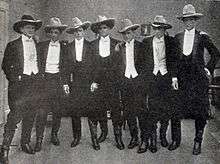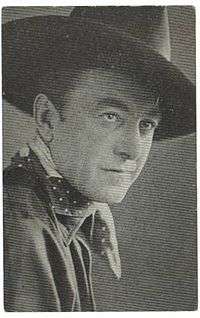Harry Carey (actor)
| Harry Carey | |
|---|---|
|
Harry Carey in 1919 | |
| Born |
Henry DeWitt Carey II January 16, 1878 The Bronx, New York, U.S. |
| Died |
September 21, 1947 (aged 69) Brentwood, California, U.S. |
| Occupation | Actor |
| Years active | 1909–1947 |
| Spouse(s) |
Olive Carey (1920–1947; his death) 2 children Fern Foster (actress) |
Harry Carey (January 16, 1878 – September 21, 1947) was an American actor and one of silent film's earliest superstars. One of his best known performances is as the President of the Senate in the drama film Mr. Smith Goes to Washington (1939), for which he was nominated for the Academy Award for Best Supporting Actor. He was the father of Harry Carey Jr., who was also a prominent actor.
Early life

Carey was born "Henry DeWitt Carey II" in the Bronx, New York, a son of Henry DeWitt Carey,[1] (A newspaper source gives the actor's name as "Harry DeWitt Carey II").[2] a prominent lawyer and judge of the New York Supreme Court, and his wife Ella J. (Ludlum). He grew up on City Island, Bronx.[3]
Carey was a cowboy, railway superintendent, author, lawyer and playwright. He attended Hamilton Military Academy, then studied law at New York University.[4]
Stage
When a boating accident led to pneumonia, he wrote a play, Montana, while recuperating and toured the country performing in it[2] for three years.[4] His play was very successful, but Carey lost it all when his next play was a failure. In 1911, his friend Henry B. Walthall introduced him to director D.W. Griffith, with whom Carey would make many films.
Carey's Broadway credits include But Not Goodbye, Ah, Wilderness, and Heavenly Express.[5]
Career

_-_Carey.jpg)
Carey first appeared in a film in 1908. He was contracted to make four films—not only acting but also doing his own stunt work.[2] He is best remembered as one of the first stars of the Western film genre.
In 1909, Carey began working for the Biograph Company. In 1911, he was signed by D.W. Griffith. His first film for Griffith was The Sorrowful Shore, a sea story.[4]
One of his most popular roles was as the good-hearted outlaw Cheyenne Harry. The Cheyenne Harry franchise spanned two decades, from A Knight of the Range (1916) to Aces Wild (1936).[6] Carey starred in director John Ford's first feature film, Straight Shooting (1918).
Carey's rugged frame and craggy features were well suited to westerns and outdoor adventures. When sound films arrived, Carey displayed an assured, gritty baritone voice that suited his rough-hewn screen personality. He was the logical choice for the title role in MGM's outdoor jungle epic Trader Horn. By this time Carey, already in his fifties, was too mature for most leading roles, and the only starring roles that he was offered were in low-budget westerns and serials. He soon settled into a comfortable career as a solid, memorable character actor; he received an Academy Award nomination for Best Supporting Actor for his role as the President of the Senate in the 1939 film Mr. Smith Goes to Washington. Among his other notable later roles were that of M/Sgt. Robert White, crew chief of the bomber "Mary Ann" in the 1943 Howard Hawks film Air Force and Mr. Melville, the cattle buyer, in Hawks's Red River. Carey made his Broadway stage debut in 1940, in Heavenly Express with John Garfield.
Personal life
He married at least twice and perhaps a third time (census records for 1910 indicate he had a wife named Clare E. Carey, and some references state that he was also married to actress Fern Foster).[7] His last marriage was to actress Olive Fuller Golden, "daughter of John Fuller Golden, one of the greatest of the vaudevillians,"[8] in 1920; they were together until his death. They purchased a 1,000-acre[2] ranch in Saugus, California, north of Los Angeles, which, in 2005, was turned into Tesoro Adobe Historic Park.[9]
The Careys had a son and a daughter.[4] Harry Carey, Jr., nicknamed Dobe,[10] would become a character actor, most famous for his roles in westerns. Father and son both appear (albeit in different scenes) in the 1948 film, Red River, and mother and son are both featured in 1956's The Searchers.
Death
Harry Carey died in 1947 from a combination of lung cancer, emphysema and coronary thrombosis, at the age of 69. He was interred in Woodlawn Cemetery in the family mausoleum in the Bronx, New York.[11]
Honors and homages
_06.jpg)
For his contribution to the motion picture industry, Harry Carey has a star in the Motion Pictures section on the Hollywood Walk of Fame at 1521 Vine Street. It was dedicated February 8, 1960.[12]
In the 1948 John Ford film, 3 Godfathers, Carey is remembered at the beginning of the film and dubbed "Bright Star of the early western sky..."
As an homage to him, John Wayne held his right elbow with his left hand in the closing shot of The Searchers, imitating a stance Carey himself often used in his films. According to Wayne, both he and Carey's widow Olive (who costarred in the film) wept when the scene was finished.
In 1976, he was inducted into the Western Performers Hall of Fame at the National Cowboy & Western Heritage Museum in Oklahoma City, Oklahoma.
In 1987, his name was emblazoned along the Walk of the Western Stars on Main Street in Old Town Newhall in Santa Clarita, California. (His son, Harry Carey Jr. was also honored in 2005).
Filmography
Radio appearances
| Year | Program | Episode/source |
|---|---|---|
| 1943 | Lux Radio Theatre | Air Force[13] |
See also
References
- ↑ rootsweb
- 1 2 3 4 Lowrance, Dee (September 7, 1941). "Hollywood Pioneer". California, San Bernardino. The San Bernardino County Sun. p. 32. Retrieved March 4, 2016 – via Newspapers.com.

- ↑ Berger, Meyer. "ABOUT NEW YORK", The New York Times, May 7, 1940. Accessed October 15, 2009. "Harry Carey's description of City Island when he was a boy in the Eighties made a hoarse and mildly profane pastorale."
- 1 2 3 4 "Harry Carey Killed Time and Was a Hit". New York, Brooklyn. The Brooklyn Daily Eagle. October 12, 1941. p. 48. Retrieved March 4, 2016 – via Newspapers.com.

- ↑ "Harry Carey". Playbill. Retrieved 5 March 2016.
- ↑ Gallagher, Tag (1986); John Ford: The Man and His Films; University of California Press, USA. See pp.502ff.
- ↑ ""Cheyenne Harry" Here in Person". Iowa, Des Moines. The Des Moines Register. March 9, 1919. p. 36. Retrieved March 4, 2016 – via Newspapers.com.

- ↑ Driscoll, C.B. (March 16, 1943). "New York Day By Day". South Carolina, Greenwood. The Index-Journal. p. 4. Retrieved March 4, 2016 – via Newspapers.com.

- ↑ Los Angeles County Parks and Recreation: Tesoro Adobe Historic Park. For more photographs, see "Places, Earth: Tesoro Adobe Historic Park".
- ↑ Bergan, Ronald (August 31, 2012). "Harry Carey Jr obituary". The Guardian. Retrieved 5 March 2016.
- ↑ Harry Carey at Find a Grave
- ↑ "Harry Carey". Hollywood Walk of Fame. Retrieved 5 March 2016.
- ↑ "Radio's Golden Age". Nostalgia Digest. 40 (1): 40–41. Winter 2014.
External links
| Wikimedia Commons has media related to Harry Carey (actor). |
- Harry Carey at the Internet Movie Database
- Harry Carey at the Internet Broadway Database

- Harry Carey at Find a Grave
- Harry Carey at Virtual History
- Finding aid authors: Mary Downs and John Murphy (2010). "Harry Carey papers". Prepared for the L. Tom Perry Special Collections, Provo, UT. Retrieved May 16, 2016.
